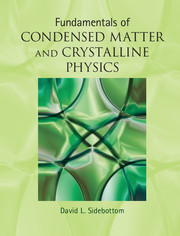 Fundamentals of Condensed Matter and Crystalline Physics
Fundamentals of Condensed Matter and Crystalline Physics from Part II - Scattering
Published online by Cambridge University Press: 05 August 2012
Introduction
In this chapter we develop a general formalism to describe the scattering of waves by a large system of particles and show that the scattering pattern relates directly to the structural arrangement of the particles. We develop this formalism using the specific example of light waves, composed of oscillating electromagnetic fields. But, in principle, the waves could represent any wave-like entity including matter waves such as traveling electrons or neutrons. The characteristic scattering pattern is known as the static structure factor, and it results from the collective interference of waves scattered by particles in the system. This interference is sensitive to the relative separation between the particles, and the static structure factor is shown to be just a spatial Fourier transform of the particle structure as it is represented by the density–density correlation function.
The dipole field
All condensed matter is constructed of atoms that contain nuclei and electrons. The nuclei reside at the atom center and the electrons, while bound up in the atom, orbit about the nucleus at a relatively large distance under the attraction of a Coulomb force. In considering the interaction of an atom with an external electric field, we know that both the electron and the nucleus experience opposing forces owing to their opposite charge. However, because neutrons and protons are about two thousand times more massive than the electron, we can largely disregard any disturbances in the location of the nucleus and instead focus on the motion of electrons alone.
To save this book to your Kindle, first ensure [email protected] is added to your Approved Personal Document E-mail List under your Personal Document Settings on the Manage Your Content and Devices page of your Amazon account. Then enter the ‘name’ part of your Kindle email address below. Find out more about saving to your Kindle.
Note you can select to save to either the @free.kindle.com or @kindle.com variations. ‘@free.kindle.com’ emails are free but can only be saved to your device when it is connected to wi-fi. ‘@kindle.com’ emails can be delivered even when you are not connected to wi-fi, but note that service fees apply.
Find out more about the Kindle Personal Document Service.
To save content items to your account, please confirm that you agree to abide by our usage policies. If this is the first time you use this feature, you will be asked to authorise Cambridge Core to connect with your account. Find out more about saving content to Dropbox.
To save content items to your account, please confirm that you agree to abide by our usage policies. If this is the first time you use this feature, you will be asked to authorise Cambridge Core to connect with your account. Find out more about saving content to Google Drive.